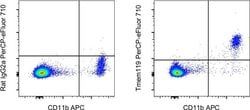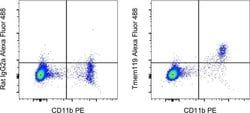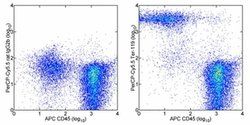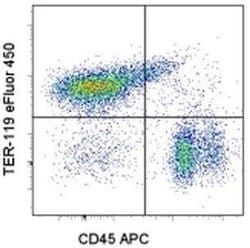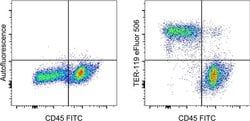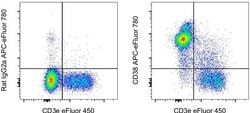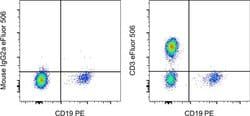7192792
Tmem119 Monoclonal Antibody (V3RT1GOsz), PE-Cyanine7, eBioscience™, Invitrogen™
Rat Monoclonal Antibody
Manufacturer: Fischer Scientific
The price for this product is unavailable. Please request a quote
Antigen
Tmem119
Concentration
0.2 mg/mL
Classification
Monoclonal
Form
Liquid
Regulatory Status
RUO
Formulation
PBS with 0.09% sodium azide; pH 7.2
Gene Alias
AW208946; BC025600; OBIF; Osteoblast induction factor; PSEC0199; Tmem119; Transmembrane protein 119; UNQ731/PRO1415
Gene Symbols
TMEM119
Isotype
IgG2a κ
Purification Method
Affinity chromatography
Product Type
Antibody
Clone
V3RT1GOsz
Applications
Flow Cytometry
Conjugate
PE-Cyanine7
Host Species
Rat
Target Species
Mouse
Gene Accession No.
Q8R138
Gene ID (Entrez)
231633
Immunogen
cell surface peptide
Primary or Secondary
Primary
Content And Storage
4° C, store in dark, DO NOT FREEZE!
Gene
TMEM119
Description
- Description: This V3RT1GOsz monoclonal antibody recognizes mouse Tmem119
- This clone has been reported to be successfully used in flow cytometry
- Applications Reported: This V3RT1GOsz antibody has been reported for use in flow cytometric analysis
- Applications Tested: This V3RT1GOsz antibody has been tested by flow cytometric analysis of mouse brain cells after myelin removal
- This may be used at less than or equal to 1.0 μg per test
- A test is defined as the amount (μg) of antibody that will stain a cell sample in a final volume of 100 μL
- Cell number should be determined empirically but can range from 10^5 to 10^8 cells/test
- It is recommended that the antibody be carefully titrated for optimal performance in the assay of interest
- Light sensitivity: This tandem dye is sensitive to photo-induced oxidation
- Please protect this vial and stained samples from light
- Fixation: Samples can be stored in IC Fixation Buffer (Product # 00-8222-49) (100 μL of cell sample + 100 μL of IC Fixation Buffer) or 1-step Fix/Lyse Solution (Product # 00-5333-57) for up to 3 days in the dark at 4°C with minimal impact on brightness and FRET efficiency/compensation
- Some generalizations regarding fluorophore performance after fixation can be made, but clone specific performance should be determined empirically
- Excitation: 488-561 nm; Emission: 775 nm; Laser: Blue Laser, Green Laser, Yellow-Green Laser Tmem119 encodes a single-pass type I transmembrane protein which seems to interact with a multitude of micro-RNAs as well as certain transcription factors such as SMAD1, SMAD5 and RUNX2
- Tmem119 has been identified as a surface marker of microglia that can be used to reliably distinguish microglia from infiltrating macrophages
- Microglial cells are phagocytes that are restricted to the brain and involved in clearing up debris and dendrite pruning of neurons
- They display a high functional plasticity, balancing neuroprotective and neurotoxic functions, which is reflected by their distinct physiology in response to changes in their microenvironment
- Microglia are particularly mobile in areas of the brain undergoing restructuring
- Reactive microglia co-express the marker Iba1
- In a pathological context, microglia have been associated with differentiation of pathogenic/inflammatory A1 type astrocytes by secretion of Cq1, IL-1a and TNF when stimulated with LPS, and thought to contribute to the pathology of several neurodegenerative diseases such as Alzheimers, Parkinsons, Chorea Huntingtons disease and Multiple Sclerosis
- The specific function Tmem119 plays on microglial cells remains unclear
- Outside of the neural system, Tmem119 seems to be involved in osteoblast differentiation/ossification.
Compare Similar Items
Show Difference
Antigen: Tmem119
Concentration: 0.2 mg/mL
Classification: Monoclonal
Form: Liquid
Regulatory Status: RUO
Formulation: PBS with 0.09% sodium azide; pH 7.2
Gene Alias: AW208946; BC025600; OBIF; Osteoblast induction factor; PSEC0199; Tmem119; Transmembrane protein 119; UNQ731/PRO1415
Gene Symbols: TMEM119
Isotype: IgG2a κ
Purification Method: Affinity chromatography
Product Type: Antibody
Clone: V3RT1GOsz
Applications: Flow Cytometry
Conjugate: PE-Cyanine7
Host Species: Rat
Target Species: Mouse
Gene Accession No.: Q8R138
Gene ID (Entrez): 231633
Immunogen: cell surface peptide
Primary or Secondary: Primary
Content And Storage: 4° C, store in dark, DO NOT FREEZE!
Gene: TMEM119
Antigen:
Tmem119
Concentration:
0.2 mg/mL
Classification:
Monoclonal
Form:
Liquid
Regulatory Status:
RUO
Formulation:
PBS with 0.09% sodium azide; pH 7.2
Gene Alias:
AW208946; BC025600; OBIF; Osteoblast induction factor; PSEC0199; Tmem119; Transmembrane protein 119; UNQ731/PRO1415
Gene Symbols:
TMEM119
Isotype:
IgG2a κ
Purification Method:
Affinity chromatography
Product Type:
Antibody
Clone:
V3RT1GOsz
Applications:
Flow Cytometry
Conjugate:
PE-Cyanine7
Host Species:
Rat
Target Species:
Mouse
Gene Accession No.:
Q8R138
Gene ID (Entrez):
231633
Immunogen:
cell surface peptide
Primary or Secondary:
Primary
Content And Storage:
4° C, store in dark, DO NOT FREEZE!
Gene:
TMEM119
Antigen: CD38
Concentration: 0.2 mg/mL
Classification: Monoclonal
Form: Liquid
Regulatory Status: RUO
Formulation: PBS with 0.09% sodium azide; pH 7.2
Gene Alias: 2'-phospho-ADP-ribosyl cyclase; 2'-phospho-ADP-ribosyl cyclase/2'-phospho-cyclic-ADP-ribose transferase; 2'-phospho-cyclic-ADP-ribose transferase; ADPRC 1; ADPRC1; ADP-ribosyl cyclase 1; ADP-ribosyl cyclase/cyclic ADP-ribose hydrolase 1; cADPr hydrolase 1; Cd38; CD38 antigen; CD38 antigen (ADP-ribosyl cyclase / cyclic ADP-ribose hydrolase); CD38 antigen (p45); CD38 antigen p45; CD38 molecule; CD38H; Cd38-rs1; cluster of differentiation 38; cyclic ADP-ribose hydrolase 1; ecto-nicotinamide adenine dinucleotide glycohydrolase; I-19; NAD(+) nucleosidase; NAD+ nucleosidase; NIM-R5 antigen; T10
Gene Symbols: CD38
Isotype: IgG2a κ
Purification Method: Affinity chromatography
Product Type: Antibody
Clone: 90
Applications: Flow Cytometry
Conjugate: APC-eFluor 780
Host Species: Rat
Target Species: Mouse
Gene Accession No.: P56528
Gene ID (Entrez): 12494
Immunogen: __
Primary or Secondary: Primary
Content And Storage: 4° C, store in dark, DO NOT FREEZE!
Gene: CD38
Antigen:
CD38
Concentration:
0.2 mg/mL
Classification:
Monoclonal
Form:
Liquid
Regulatory Status:
RUO
Formulation:
PBS with 0.09% sodium azide; pH 7.2
Gene Alias:
2'-phospho-ADP-ribosyl cyclase; 2'-phospho-ADP-ribosyl cyclase/2'-phospho-cyclic-ADP-ribose transferase; 2'-phospho-cyclic-ADP-ribose transferase; ADPRC 1; ADPRC1; ADP-ribosyl cyclase 1; ADP-ribosyl cyclase/cyclic ADP-ribose hydrolase 1; cADPr hydrolase 1; Cd38; CD38 antigen; CD38 antigen (ADP-ribosyl cyclase / cyclic ADP-ribose hydrolase); CD38 antigen (p45); CD38 antigen p45; CD38 molecule; CD38H; Cd38-rs1; cluster of differentiation 38; cyclic ADP-ribose hydrolase 1; ecto-nicotinamide adenine dinucleotide glycohydrolase; I-19; NAD(+) nucleosidase; NAD+ nucleosidase; NIM-R5 antigen; T10
Gene Symbols:
CD38
Isotype:
IgG2a κ
Purification Method:
Affinity chromatography
Product Type:
Antibody
Clone:
90
Applications:
Flow Cytometry
Conjugate:
APC-eFluor 780
Host Species:
Rat
Target Species:
Mouse
Gene Accession No.:
P56528
Gene ID (Entrez):
12494
Immunogen:
__
Primary or Secondary:
Primary
Content And Storage:
4° C, store in dark, DO NOT FREEZE!
Gene:
CD38
Antigen: CD140b (PDGFRB)
Concentration: 0.2 mg/mL
Classification: Monoclonal
Form: Liquid
Regulatory Status: RUO
Formulation: PBS with 0.09% sodium azide; pH 7.2
Gene Alias: AI528809; Beta platelet-derived growth factor receptor; beta-type platelet-derived growth factor receptor; CD140 antigen-like family member B; CD140B; CD140b antigen; IBGC4; IMF1; JTK12; KOGS; PDGF beta chain; PDGF Receptor beta; Pdgfr; Pdgfr1; PDGFR-1; PDGFRB; PDGF-R-beta; PDGFR-beta; PENTT; platelet derived growth factor receptor beta; platelet derived growth factor receptor, beta polypeptide; platelet-derived growth factor receptor 1; Platelet-derived growth factor receptor beta; platelet-derived growth factor receptor beta variant 1; Platelet-derived growth factor receptor, beta; platelet-derived growth factor receptor, beta polypeptide
Gene Symbols: Pdgfrb
Isotype: IgG2a κ
Purification Method: Affinity chromatography
Product Type: Antibody
Clone: APB5
Applications: Flow Cytometry
Conjugate: PE-Cyanine7
Host Species: Rat
Target Species: Mouse
Gene Accession No.: P05622
Gene ID (Entrez): 18596
Immunogen: __
Primary or Secondary: Primary
Content And Storage: 4° C, store in dark, DO NOT FREEZE!
Gene: Pdgfrb
Antigen:
CD140b (PDGFRB)
Concentration:
0.2 mg/mL
Classification:
Monoclonal
Form:
Liquid
Regulatory Status:
RUO
Formulation:
PBS with 0.09% sodium azide; pH 7.2
Gene Alias:
AI528809; Beta platelet-derived growth factor receptor; beta-type platelet-derived growth factor receptor; CD140 antigen-like family member B; CD140B; CD140b antigen; IBGC4; IMF1; JTK12; KOGS; PDGF beta chain; PDGF Receptor beta; Pdgfr; Pdgfr1; PDGFR-1; PDGFRB; PDGF-R-beta; PDGFR-beta; PENTT; platelet derived growth factor receptor beta; platelet derived growth factor receptor, beta polypeptide; platelet-derived growth factor receptor 1; Platelet-derived growth factor receptor beta; platelet-derived growth factor receptor beta variant 1; Platelet-derived growth factor receptor, beta; platelet-derived growth factor receptor, beta polypeptide
Gene Symbols:
Pdgfrb
Isotype:
IgG2a κ
Purification Method:
Affinity chromatography
Product Type:
Antibody
Clone:
APB5
Applications:
Flow Cytometry
Conjugate:
PE-Cyanine7
Host Species:
Rat
Target Species:
Mouse
Gene Accession No.:
P05622
Gene ID (Entrez):
18596
Immunogen:
__
Primary or Secondary:
Primary
Content And Storage:
4° C, store in dark, DO NOT FREEZE!
Gene:
Pdgfrb
Antigen: CD3
Concentration: 5 μL/Test
Classification: Monoclonal
Form: Liquid
Regulatory Status: RUO
Formulation: PBS with 0.2% BSA and 0.09% sodium azide; pH 7.2
Gene Alias: 4930549J05Rik; A430104F18Rik; AI504783; antigen CD3D, delta polypeptide (TiT3 complex); antigen CD3E, epsilon polypeptide (TiT3 complex); antigen CD3G, gamma polypeptide; antigen CD3Z, zeta polypeptide; AW552088; Cd247; CD247 antigen; CD247 antigen, zeta subunit; Cd247 molecule; CD3; CD3 antigen delta chain; CD3 antigen delta polypeptide; CD3 antigen gamma chain; CD3 antigen, delta polypeptide; CD3 antigen, delta subunit; CD3 antigen, epsilon polypeptide; CD3 antigen, gamma polypeptide; CD3 antigen, zeta polypeptide; CD3 delta; CD3 epsilon; CD3 epsilon chain; CD3 epsilon subunit; CD3 epsilon subunit precursor; CD3 gamma-chain; CD3 glycoprotein; CD3 glycoprotein precursor; CD3 molecule delta polypeptide; CD3 molecule, delta; CD3 molecule, epsilon; CD3 molecule, epsilon polypeptide; CD3 molecule, gamma; CD3 molecule, gamma polypeptide; CD3 protein; CD3 TCR complex; CD3 type I transmembrane glycoprotein; CD3 type I transmembrane glycoprotein precursor; CD3 zeta chain; Cd3d; CD3D antigen delta; CD3D antigen, delta polypeptide (TiT3 complex); CD3d molecule; CD3d molecule, delta (CD3-TCR complex); CD3-DELTA; Cd3e; CD3E antigen, epsilon polypeptide; CD3E antigen, epsilon polypeptide (TiT3 complex); CD3e molecule; CD3e molecule, epsilon (CD3-TCR complex); CD3epsilon; CD3-epsilon; Cd3-eta; Cd3g; CD3G antigen, gamma polypeptide; CD3g antigen, gamma polypeptide (TiT3 complex); CD3g molecule; CD3g molecule, epsilon (CD3-TCR complex); CD3g molecule, gamma (CD3-TCR complex); CD3-GAMMA; Cd3h; CD3Q; Cd3z; CD3Z antigen, zeta polypeptide (TiT3 complex); Cd3zeta; Cd3-zeta; CD3zeta chain; CD3-zeta/eta; Ctg3; Ctg-3; FLJ18683; IMD17; IMD18; IMD19; IMD25; Leu-4; OKT3, delta chain; T cell antigen receptor complex epsilon subunit of T3; T3/TCR complex; T3d; T3e; T3g; T3Z; T-cell antigen receptor complex, epsilon subunit of T3; T-cell antigen receptor complex, gamma subunit of T3; T-cell antigen receptor complex, zeta subunit of CD3; T-cell receptor CD3 epsilon chain; T-cell receptor CD3 epsilon subunit; T-cell receptor CD3 subunit zeta; T-cell receptor CD3, subunit zeta; T-cell receptor T3 delta chain; T-cell receptor T3 eta chain; T-cell receptor T3 gamma chain; T-cell receptor T3 zeta chain; T-cell receptor zeta chain; T-cell surface antigen T3/Leu-4 epsilon chain; T-cell surface glycoprotein CD3 delta chain; T-cell surface glycoprotein CD3 epsilon chain; T-cell surface glycoprotein CD3 gamma chain; T-cell surface glycoprotein CD3 zeta chain; T-cell surface protein; TcR CD3 delta-chain; TcR CD3 gamma-chain; TCR zeta chain; TCR zeta chain subunit; TCRE; Tcrk; TCRZ; TCRzeta; TiT3 complex; type I transmembrane protein; T-cell surface molecule CD3
Gene Symbols: Cd247, Cd3d, CD3E, CD3g
Isotype: IgG2a κ
Purification Method: Affinity chromatography
Product Type: Antibody
Clone: OKT3
Applications: Flow Cytometry
Conjugate: eFluor 506
Host Species: Mouse
Target Species: Human
Gene Accession No.: P04234, P07766, P09693, P20963
Gene ID (Entrez): 915, 916, 917, 919
Immunogen: __
Primary or Secondary: Primary
Content And Storage: 4° C, store in dark, DO NOT FREEZE!
Gene: __
Antigen:
CD3
Concentration:
5 μL/Test
Classification:
Monoclonal
Form:
Liquid
Regulatory Status:
RUO
Formulation:
PBS with 0.2% BSA and 0.09% sodium azide; pH 7.2
Gene Alias:
4930549J05Rik; A430104F18Rik; AI504783; antigen CD3D, delta polypeptide (TiT3 complex); antigen CD3E, epsilon polypeptide (TiT3 complex); antigen CD3G, gamma polypeptide; antigen CD3Z, zeta polypeptide; AW552088; Cd247; CD247 antigen; CD247 antigen, zeta subunit; Cd247 molecule; CD3; CD3 antigen delta chain; CD3 antigen delta polypeptide; CD3 antigen gamma chain; CD3 antigen, delta polypeptide; CD3 antigen, delta subunit; CD3 antigen, epsilon polypeptide; CD3 antigen, gamma polypeptide; CD3 antigen, zeta polypeptide; CD3 delta; CD3 epsilon; CD3 epsilon chain; CD3 epsilon subunit; CD3 epsilon subunit precursor; CD3 gamma-chain; CD3 glycoprotein; CD3 glycoprotein precursor; CD3 molecule delta polypeptide; CD3 molecule, delta; CD3 molecule, epsilon; CD3 molecule, epsilon polypeptide; CD3 molecule, gamma; CD3 molecule, gamma polypeptide; CD3 protein; CD3 TCR complex; CD3 type I transmembrane glycoprotein; CD3 type I transmembrane glycoprotein precursor; CD3 zeta chain; Cd3d; CD3D antigen delta; CD3D antigen, delta polypeptide (TiT3 complex); CD3d molecule; CD3d molecule, delta (CD3-TCR complex); CD3-DELTA; Cd3e; CD3E antigen, epsilon polypeptide; CD3E antigen, epsilon polypeptide (TiT3 complex); CD3e molecule; CD3e molecule, epsilon (CD3-TCR complex); CD3epsilon; CD3-epsilon; Cd3-eta; Cd3g; CD3G antigen, gamma polypeptide; CD3g antigen, gamma polypeptide (TiT3 complex); CD3g molecule; CD3g molecule, epsilon (CD3-TCR complex); CD3g molecule, gamma (CD3-TCR complex); CD3-GAMMA; Cd3h; CD3Q; Cd3z; CD3Z antigen, zeta polypeptide (TiT3 complex); Cd3zeta; Cd3-zeta; CD3zeta chain; CD3-zeta/eta; Ctg3; Ctg-3; FLJ18683; IMD17; IMD18; IMD19; IMD25; Leu-4; OKT3, delta chain; T cell antigen receptor complex epsilon subunit of T3; T3/TCR complex; T3d; T3e; T3g; T3Z; T-cell antigen receptor complex, epsilon subunit of T3; T-cell antigen receptor complex, gamma subunit of T3; T-cell antigen receptor complex, zeta subunit of CD3; T-cell receptor CD3 epsilon chain; T-cell receptor CD3 epsilon subunit; T-cell receptor CD3 subunit zeta; T-cell receptor CD3, subunit zeta; T-cell receptor T3 delta chain; T-cell receptor T3 eta chain; T-cell receptor T3 gamma chain; T-cell receptor T3 zeta chain; T-cell receptor zeta chain; T-cell surface antigen T3/Leu-4 epsilon chain; T-cell surface glycoprotein CD3 delta chain; T-cell surface glycoprotein CD3 epsilon chain; T-cell surface glycoprotein CD3 gamma chain; T-cell surface glycoprotein CD3 zeta chain; T-cell surface protein; TcR CD3 delta-chain; TcR CD3 gamma-chain; TCR zeta chain; TCR zeta chain subunit; TCRE; Tcrk; TCRZ; TCRzeta; TiT3 complex; type I transmembrane protein; T-cell surface molecule CD3
Gene Symbols:
Cd247, Cd3d, CD3E, CD3g
Isotype:
IgG2a κ
Purification Method:
Affinity chromatography
Product Type:
Antibody
Clone:
OKT3
Applications:
Flow Cytometry
Conjugate:
eFluor 506
Host Species:
Mouse
Target Species:
Human
Gene Accession No.:
P04234, P07766, P09693, P20963
Gene ID (Entrez):
915, 916, 917, 919
Immunogen:
__
Primary or Secondary:
Primary
Content And Storage:
4° C, store in dark, DO NOT FREEZE!
Gene:
__
